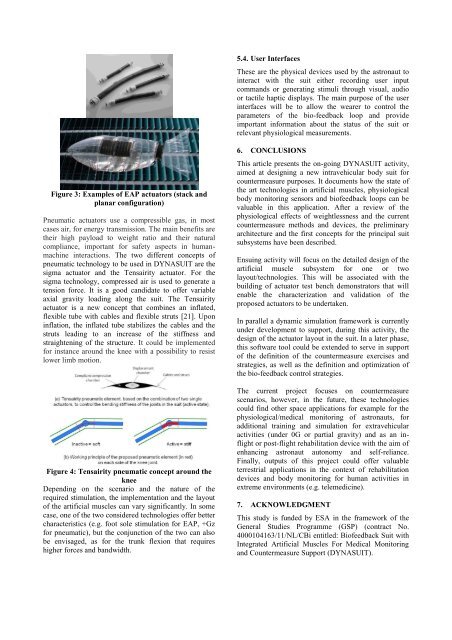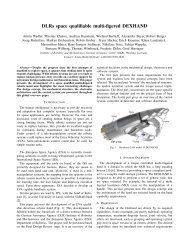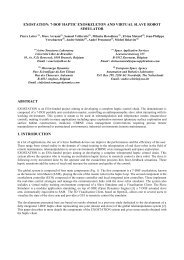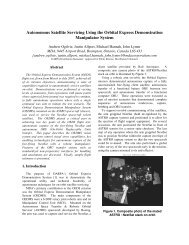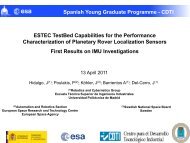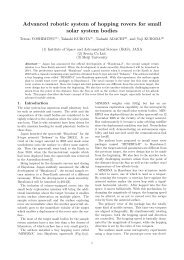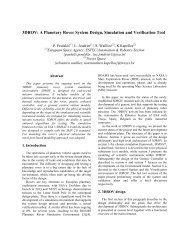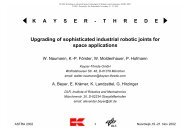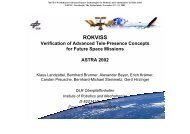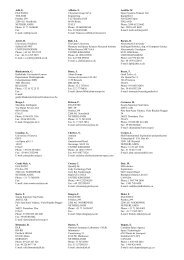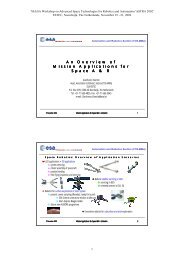DYNASUIT, an Intelligent Space Countermeasure - ESA - Robotics
DYNASUIT, an Intelligent Space Countermeasure - ESA - Robotics
DYNASUIT, an Intelligent Space Countermeasure - ESA - Robotics
Create successful ePaper yourself
Turn your PDF publications into a flip-book with our unique Google optimized e-Paper software.
Figure 3: Examples of EAP actuators (stack <strong>an</strong>d<br />
pl<strong>an</strong>ar configuration)<br />
Pneumatic actuators use a compressible gas, in most<br />
cases air, for energy tr<strong>an</strong>smission. The main benefits are<br />
their high payload to weight ratio <strong>an</strong>d their natural<br />
compli<strong>an</strong>ce, import<strong>an</strong>t for safety aspects in hum<strong>an</strong>machine<br />
interactions. The two different concepts of<br />
pneumatic technology to be used in <strong>DYNASUIT</strong> are the<br />
sigma actuator <strong>an</strong>d the Tensairity actuator. For the<br />
sigma technology, compressed air is used to generate a<br />
tension force. It is a good c<strong>an</strong>didate to offer variable<br />
axial gravity loading along the suit. The Tensairity<br />
actuator is a new concept that combines <strong>an</strong> inflated,<br />
flexible tube with cables <strong>an</strong>d flexible struts [21]. Upon<br />
inflation, the inflated tube stabilizes the cables <strong>an</strong>d the<br />
struts leading to <strong>an</strong> increase of the stiffness <strong>an</strong>d<br />
straightening of the structure. It could be implemented<br />
for inst<strong>an</strong>ce around the knee with a possibility to resist<br />
lower limb motion.<br />
Figure 4: Tensairity pneumatic concept around the<br />
knee<br />
Depending on the scenario <strong>an</strong>d the nature of the<br />
required stimulation, the implementation <strong>an</strong>d the layout<br />
of the artificial muscles c<strong>an</strong> vary signific<strong>an</strong>tly. In some<br />
case, one of the two considered technologies offer better<br />
characteristics (e.g. foot sole stimulation for EAP, +Gz<br />
for pneumatic), but the conjunction of the two c<strong>an</strong> also<br />
be envisaged, as for the trunk flexion that requires<br />
higher forces <strong>an</strong>d b<strong>an</strong>dwidth.<br />
5.4. User Interfaces<br />
These are the physical devices used by the astronaut to<br />
interact with the suit either recording user input<br />
comm<strong>an</strong>ds or generating stimuli through visual, audio<br />
or tactile haptic displays. The main purpose of the user<br />
interfaces will be to allow the wearer to control the<br />
parameters of the bio-feedback loop <strong>an</strong>d provide<br />
import<strong>an</strong>t information about the status of the suit or<br />
relev<strong>an</strong>t physiological measurements.<br />
6. CONCLUSIONS<br />
This article presents the on-going <strong>DYNASUIT</strong> activity,<br />
aimed at designing a new intravehicular body suit for<br />
countermeasure purposes. It documents how the state of<br />
the art technologies in artificial muscles, physiological<br />
body monitoring sensors <strong>an</strong>d biofeedback loops c<strong>an</strong> be<br />
valuable in this application. After a review of the<br />
physiological effects of weightlessness <strong>an</strong>d the current<br />
countermeasure methods <strong>an</strong>d devices, the preliminary<br />
architecture <strong>an</strong>d the first concepts for the principal suit<br />
subsystems have been described.<br />
Ensuing activity will focus on the detailed design of the<br />
artificial muscle subsystem for one or two<br />
layout/technologies. This will be associated with the<br />
building of actuator test bench demonstrators that will<br />
enable the characterization <strong>an</strong>d validation of the<br />
proposed actuators to be undertaken.<br />
In parallel a dynamic simulation framework is currently<br />
under development to support, during this activity, the<br />
design of the actuator layout in the suit. In a later phase,<br />
this software tool could be extended to serve in support<br />
of the definition of the countermeasure exercises <strong>an</strong>d<br />
strategies, as well as the definition <strong>an</strong>d optimization of<br />
the bio-feedback control strategies.<br />
The current project focuses on countermeasure<br />
scenarios, however, in the future, these technologies<br />
could find other space applications for example for the<br />
physiological/medical monitoring of astronauts, for<br />
additional training <strong>an</strong>d simulation for extravehicular<br />
activities (under 0G or partial gravity) <strong>an</strong>d as <strong>an</strong> inflight<br />
or post-flight rehabilitation device with the aim of<br />
enh<strong>an</strong>cing astronaut autonomy <strong>an</strong>d self-reli<strong>an</strong>ce.<br />
Finally, outputs of this project could offer valuable<br />
terrestrial applications in the context of rehabilitation<br />
devices <strong>an</strong>d body monitoring for hum<strong>an</strong> activities in<br />
extreme environments (e.g. telemedicine).<br />
7. ACKNOWLEDGMENT<br />
This study is funded by <strong>ESA</strong> in the framework of the<br />
General Studies Programme (GSP) (contract No.<br />
4000104163/11/NL/CBi entitled: Biofeedback Suit with<br />
Integrated Artificial Muscles For Medical Monitoring<br />
<strong>an</strong>d <strong>Countermeasure</strong> Support (<strong>DYNASUIT</strong>).


